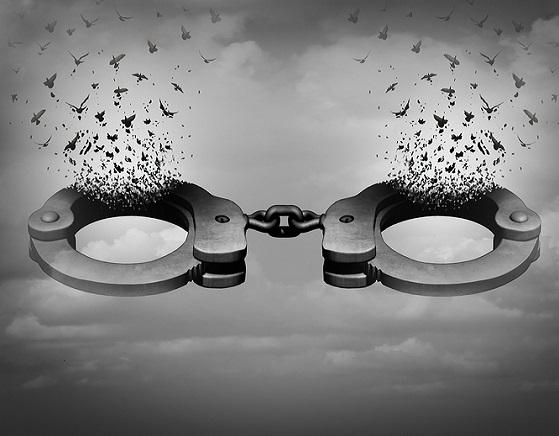Unknown Prisoner Suicides: An Inmate Is Still a Human.

At 23 years of age, I was arrested for bank robbery. Escorted into the county jail, an intake psychologist asked if I’d ever had thoughts of suicide.
I wasn’t expecting the question. It caught me off guard, considering I was just thinking about killing myself. “Is she reading my mind?” I thought. Out loud, I said, “Yes.”
Her body language changed, as if surprised by my response. “Are you considering suicide right now?”
“Oh yes,” I responded.
She had me escorted to a separate wing of the jail, a place seemingly void of life. I was locked in a cell by myself. The quiet became deafening. I saw no one until the following morning, when they brought me a breakfast tray. This was their response to a potential suicide. It seemed to say, “Put him off to the side, out of sight, out of mind, where there won’t be any witnesses to contest what narrative we may have to create.”
For me, thoughts of suicide were a response to walls rapidly closing in, presenting a means of escape where none otherwise seemed to exist.
Statistically speaking, county jails have the highest inmate suicide rate, compared to state and federal prisons. And if an inmate coming into a county jail is going to commit suicide, chances are it’s going to happen within the first 90 days following their arrest.
The shock of suddenly being thrust into a foreign environment so far outside anything experienced before, having only your worst nightmare scenarios to consult and keep you company, generates a “bottom falling out” internal emptying effect that drains the life out of you down to the depths of your soul.
It’s an actual physical sensation that feels like a black hole ripping open inside your body, sucking out all the light and life within, leaving a cold darkness and desperate need for death’s saving embrace, if only to break free from the never-before experienced pain of pure emptiness.
It makes me think of what the fish must experience when pulled out of the water; the deer when caught in the lion’s mouth; the tiger when captured in the cage.
It’s an experience I’d never wish on anyone or -thing, and it’s a testament to the immense power of life that any living creature survives that initial animalistic explosion of pure panic.
Obviously I survived. I overcame the shock of sudden change, guided out by an unexpected visitor’s compassion. A spiritual mentor showed up just in time.
And for those who do survive it, they’re changed forever. Because, what it is we experienced is a complete implosion of the ego, that false sense of self comprised of all the ideas, attitudes, beliefs and expectations with which we’re fooled into completely identifying.
If the person never had anything spiritual to connect with, the ego is all he had and, if he survives the impulse to chase its blink of death with suicide, then all he has left is to go completely mad.
But for those who have been graced with a degree of spiritual connection, allowing us at least a subconscious awareness of our true selves, ego’s blink of death serves to break us free from its control. Its death brings awakening, and with it, a new perspective on life.
But some run back, reconnecting the links of ego’s chains of limitation, attempting to go back to sleep, though the connection will never be quite the same. The memory of the light behind the darkness will always get in the way.
But even for these, at least they survived. They lived to see another day. And for those who hold on to the memory of spirit’s light shining behind ego’s otherwise perpetually overcast sky, yes, they may go on to know days physically confined in cages, but within them the light evolves into arms and hearts opening to each day’s sun’s rising gleaned through disappeared bars and concertina wire.
The sun’s light does its work, shining inward to burn away all that serves only to hold back the eternal light within from shining out.
And with each day’s dawn within and without, we become brighter… if allowed.
But not everyone allows. If the initial shock of incarceration is an earth-shattering quake, then for some of the survivors, the aftershocks of continued loss — job, home, relationships — if these occur faster than ego’s dissolution, serve to overwhelm the tenuous beginnings of spiritual awakening, blinding the person into perceived darkness before they get to fully bathe in and understand the light.
Heartbreakingly, they’re discovered hanging by a bed sheet from their bunk.
The statistics on inmates committing suicide curiously seem to only be available in any meaningfully measurable sense from the year 2000 to 2014. But within that time frame, a pattern is revealed: a steady incline.
This is also the case for suicides committed in society by free citizens, though at a lower ratio when compared to inmates. For example, from 2000 to 2013, the prison suicide rate rose to 15 suicides for every 100,000 inmates. Depending on what study you read, the national average of non-prisoners comparatively was last set at 11 people per 100,000.
But from 2013 to 2014, the number of suicides among state prisoners climbed from 192 to 249, a 30% increase. In 2014, suicides made up 7% of all state prisoner deaths, the largest percentage since 2001.
In 2014, a separate report says that the average combined daily population of all the county jails numbered at 750,128 inmates. Out of these, 392 committed suicide, representing 37% of all jail deaths for that year. This translates into a suicide rate for jail inmates of 45 per 100,000. About 47% of the suicides occurred in general population, while 20% were in special housing units (aka SHU, or “The Hole”).
All together, in 2014 suicides among jail prisoners were up 13% from 2013.
At the end of 2014, an estimated 1,433,800 prisoners were held in our nation’s state and federal facilities. During that year, out of the nearly 200,000 federal prisoners, 444 died. Disconcertingly, it’s seemingly impossible to determine how many of them were the result of suicide.
Who were these people? What are their stories? Considering how many billions in tax dollars are given to jails and prisons in part for the inmates’ care, why do we not know about what happened?
Is a broken and lost human being not human, lacking any need for attention?
Each prison facility has policy that says the correctional officers have to walk rounds, visually checking on the well-being of the prisoners every 15 to 30 minutes. This policy is rarely followed. More often, the only time guards see the inmates is when the guards conduct the mandatory counts. These occur once a day on Mondays through Fridays, and twice a day on the weekends.
Beyond the issue with the rounds, at any given moment, at any one of the 122 federal prison facilities, an inmate is being held on Suicide Watch, being watched by an Inmate Suicide Watch Companion. Known as Companions, these are inmates who’ve been trained to watch other inmates who’ve threatened self-harm behavior.
Companions are used so the BOP can save the cost that would otherwise be spent on paying correctional officers to do the job.
I worked as a Companion for eight years. The other reason, I learned, that Inmate Companions are used is because as stated by Psychology staff, the officers can’t be trusted to do the job. Inmates prove far more trustworthy, inclined as we are to be empathetic toward, and wanting to look out for, one of our own.
Staff will fall asleep, or just leave their post.
The inmate being held on watch is isolated in a large cell that’s located in the prison’s Medical Department, designated for this purpose. The cell provides large windows through which the inmate can be observed from an adjacent room.
The Companion is tasked with using a phone to call the Control officer every 30 minutes to give a situation report, or an “All Clear.” Nearly all the Control officers, especially those working during night shift, either refuse to answer, or, when they do, say rude and disrespectful things, most often in line with “Stop f*@!ing calling!” They don’t care. They just want to sleep.
The isolation room is purposefully kept freezing cold, and the lights are kept on 24 hours a day, seven days a week. The inmate is made to wear only a smock, and he never sees outside of that cell for as long as he’s on watch. The Psychology Department says they make the conditions extremely harsh just in case the inmate is faking being suicidal.
And so inmates with stitches and bandages on their wrists, or ligature marks around their necks, are frozen and sleep-deprived, making them more miserable.
An inmate is held on Suicide Watch from a few days to a few weeks.
A cursory interview is conducted by an on-staff psychologist in order to determine if the inmate is still in a suicidal mindset. The inmate, wanting nothing more to do with the harsh conditions of being on watch, makes all the necessary assurances that he’s no longer suicidal. Then he’s returned to general population, or the SHU, depending on from where he was pulled. No one conducts a follow-up interview.
Now the inmate wants nothing to do with the Psychology staff, or their treatment. There seems to be a pattern of waiting for about two weeks. Having learned from his mistakes, he doesn’t repeat them on his next attempt. It usually takes a while for the officer to discover the body.
It’s a repeating pattern. And two contributing factors are the harsh conditions of being placed on watch and, following being released from watch, there being no follow-up by staff. The Psychology staff’s protocol, as announced August 22, 2019, at a town-hall meeting held in my housing unit, is that the inmate has to come to them and ask for help.
Never mind that a suicide attempt is arguably one of the loudest cries for help a person can make. If he’s talked himself off of being on Suicide Watch, it’s his responsibility to come to them afterward? Not the other way around? And if he doesn’t, if instead he successfully completes the act, the prison Psychology staff says it was the inmate’s decision and no one else’s fault.
Throughout the BOP, the authority is comprised of a culture deeply ingrained with apathy or hate. Either way, they’re taught to see people in prison as less than human.
And as history reveals, when a class of people are culturally dehumanized, then compassion becomes non-existent. And all motivation toward helping someone who’s been regulated into a sub-class fades to nothing. Instead, the predominating motivation among the authority is to neglect or destroy.
Being part of such a sub-class is arguably one of life’s greatest frustrations and heartbreaks. It serves only to break the broken further, ensuring they’re filled with greater pain. And since only hurt people hurt people, if they’re not projecting that pain outwardly, they’re going to direct it at themselves.
And the consequences become an annual pattern of increase in unknown prisoners committing suicide.
Until we hear about Jeffrey Epstein. Wealthy and politically connected.
Newsworthy.
At MCC New York, he was found in his cell, alone, unconscious, on the floor with bruises around his neck. One of the predominating stories was he was just trying to manipulate the system. Why? Because, once we label someone a monster, we refuse to see them as a human being in pain.
And arguably, someone who visits so much pain on young women must be drawing from a deep well’s worth. But hate blinds, allowing us to feel permitted to be monstrous toward those so labeled. The result: we pour into the world more pain.
He was placed on Suicide Watch. Then staff put him back in SHU, in a room by himself. Two weeks later, he was found dead, hanging from a bed sheet.
Epstein’s wealth and connections allowed a small peek into the Bureau of Prison’s operations. If they failed to prevent the suicide of someone who was under the highest level of scrutiny, imagine what they fail to do for those inmates who’re poor, unknown and ignored by the world.
A friend of mine, Shawn Gant, was, to the world, poor and unknown. To those of us in here who had the distinct honor to call him friend, Shawn was one of the smartest and funniest people we’ve ever met. He’s the guy to whom we all brought our electronics when they needed fixing.
There seemingly was nothing broken he couldn’t put back together again.
He’s the guy who could dissolve any situation into riotous laughter. He could be counted on to turn any frown upside down.
While Jeffrey Epstein filled the TV screens of every news broadcast, Shawn tried to kill himself, cutting his wrist with a pair of sharpened scissors. His attempt failed, resulting in the Medical Department bandaging up the wounds and referring him to the Psychology Department.
The psychologist conducted a cursory interview and had Shawn sign a form stating he was no longer suicidal. They didn’t place him on Suicide Watch. A signed form spoke louder to apathy’s ears than bleeding wrists. And hate, implicit or otherwise, sent him back into GP. To them he was just another Register number: 11176-029.
They never once followed up with him.
It’s been written that we’re not bad people trying to learn how to be good. We’re broken people trying to put the pieces back together again. With all Shawn could fix, he couldn’t find a way to fix what was hurting within. With all the smiles he made, there was a frown within he couldn’t quite find his way into. And those tasked with helping failed him.
About two weeks later, on a Saturday, Shawn was found hanging from a bed sheet noose tied to his bunk, dead in his cell for over an hour.
In nearly 20 years of incarceration, I’ve never seen or heard about a town-hall meeting being held in response to a suicide. Jeffrey Epstein has BOP staff worried the truth may come out. They wanted to see if they could take control of the narrative. The psychologist said it wasn’t their fault, that Shawn was the one who decided to do this.
They blamed him.
But did the BOP really have to worry? He wasn’t wealthy or politically connected. Instead he was rich in contribution and friends, and yet weighed down within by pain.
But my heart is a news anchor, telling me Shawn Gant’s story, and the impact he had on my life as a friend. It’s saying I miss him. It’s also saddened that he wasn’t deemed worthy of the help he had cried out for.
On that day when I first stepped into the county jail, I knew his pain, and so I share his message on behalf of all the unknown people behind the inmate statistics data. It’s a message that screams: “I am lost and hurting. I don’t know what to do. I know I’ve made mistakes in life, but please help.”
Will anyone listen?
***

For nearly two decades, Brian Zater has been teaching federal prisoners personal development, rehabilitation and reentry preparation classes based on higher consciousness studies. Learning from his own struggles and personal growth, his work has done the difficult job of equipping broken men with the tools to put themselves back together again.All of his past students who’ve since returned to society have become life-long contributors, most as successful family-men and small business owners. A strong advocate for positive social change, he also reaches outside his walls, serving as teacher, mentor and life coach, helping people from all walks of life break free from their personal chains of limitation, find their life’s purpose and achieve their full potentials. You could contact him via Facebook, read his first Rebelle Society article, and look out for his book, The Tree of Life, Sowing Your Seeds of Destiny, available November 2019.
***
{Join us on Facebook, Twitter, Instagram & Pinterest}

